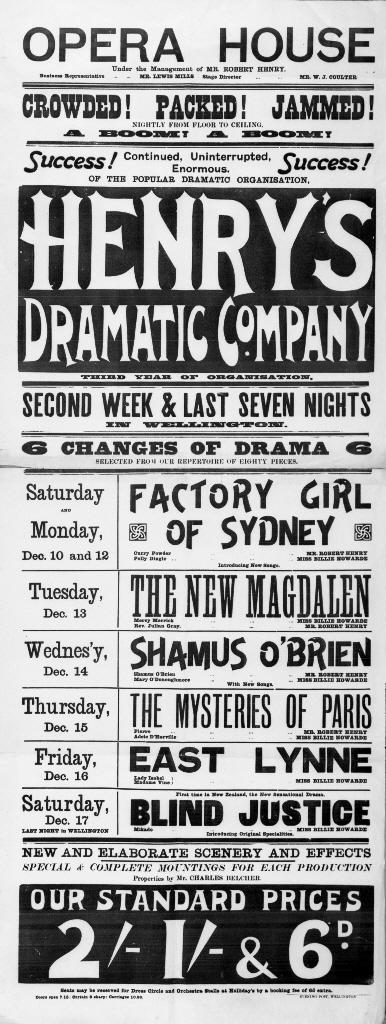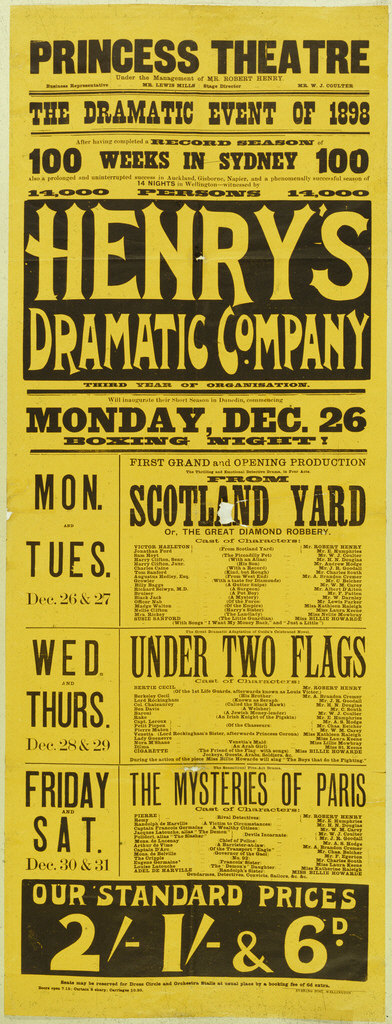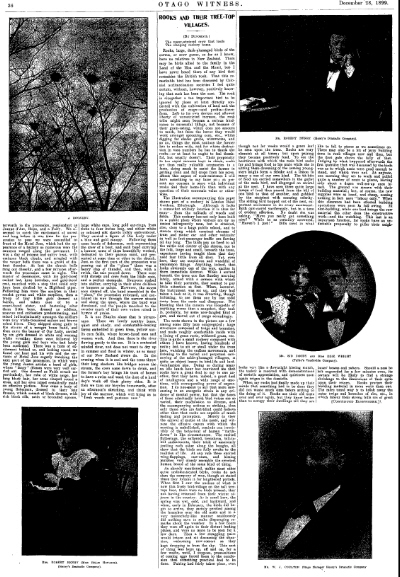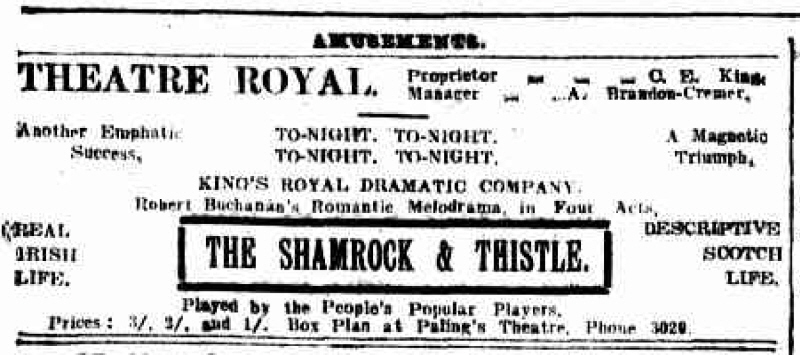|
Play List: 4. Corinne 7. The Mormons 9. Lucy Brandon 10. Storm-Beaten 11. Lady Clare 13. Bachelors 14. Constance 15. Lottie 16. Agnes 17. Alone in London 18. Sophia 19. Fascination 20. The Blue Bells of Scotland 21. Partners 24. Angelina! 25. The Old Home 26. A Man’s Shadow 27. Theodora 29. Clarissa 30. Miss Tomboy 32. Sweet Nancy 33. The English Rose 36. Marmion 37. The Gifted Lady 38. The Trumpet Call 39. Squire Kate 40. The White Rose 42. The Black Domino 44. The Charlatan 45. Dick Sheridan 47. Lady Gladys 48. The Strange Adventures of Miss Brown 49. The Romance of the Shopwalker 52. Two Little Maids from School ___ |
|
ROBERT WILLIAMS BUCHANAN (1841 - 1901) |
|
|
|
|
|
|
|
|
THE SHAMROCK AND THE THISTLE
I picked this up from a couple of newspaper items from Australia which mentioned that a touring production of The Shamrock and the Thistle was based upon Robert Buchanan’s novel, Lady Kilpatrick. Certainly the plot was the same, but the names of the characters had been changed; not, I would suggest, to protect the innocent, but more to shield the guilty. The first appearance of The Shamrock and the Thistle was in 1898 and was performed by the Henry Dramatic Company. It had been adapted from Lady Kilpatrick by the Company’s actor-manager, Robert Henry (aka Robert Henry Nicholls, who was later taken to court on two occasions for theatrical plagiarism) and another actor with the Company, W. J. Coulter. Robert Henry had spent some time as an assistant stage manager with the Brough and Boucicault Company which is perhaps coincidental and nothing more; too slight to make a case for The Shamrock and the Thistle being a version of The Squireen. There does not seem to be any evidence either for Buchanan knowing about this antipodean version of Lady Kilpatrick and certainly no evidence that he tried to have it stopped. The Shamrock and the Thistle seems to stop being part of the Henry Dramatic Company’s repertoire in 1900. It then reappears in June, 1914 for several performances at Brisbane’s Theatre Royal. Presented by King’s Royal Dramatic Company this version, again keeps the plot of Lady Kilpatrick, but names of the characters are changed again. So, whether this was a new adaptation of the novel, or a reworking of Henry & Coulter’s adaptation, I have no idea. ___
The Sydney Morning Herald (Sydney, New South Wales) (27 August, 1898 - p.10) ROYAL STANDARD THEATRE. “The Shamrock and the Thistle” will be produced at the Royal Standard Theatre to-night by Henry’s Dramatic Company. Mr. Robert Henry as Lindsay, a trusted servant, and Miss Billie Howarde as Lady Elsie, will be supported by a cast of 12 characters in the Irish drama. A movement is now on foot to organise a benefit entertainment for Mr. and Mrs. Henry prior to their departure for New Zealand. ___
Truth (Sydney, New South Wales) (28 August, 1898 - p.2) |
 |
|
THE ROYAL STANDARD. THE Henry Dramatic Company put on ‘The Shamrock and the Thistle,’ before a crowded house, last night. The piece went with remarkable smoothness and the various stirring situations and incidents were finely mounted and given proper prominence to by the clever company. Miss Billie Howarde looked charming and played splendidly as Lady Elsie Fitzgerald and Mr Henry made the part of Lindsay a masterpiece. ‘The Shamrock and the Thistle’ will be staged again on Monday and Tuesday nights. The Henry Company leaves for a New Zealand tour on September 28 and with a view to according the talented and popular pair, Mr and Mrs Henry (Miss Billie Howarde) a fitting farewell, a meeting was convened, at Quong Tart’s rooms, King-street, on Friday afternoon. Mr J. M. Chanter, M L A. was voted to the chair and after a considerable amount of discussion, during which all present evinced a most hearty unanimity in the desire to give them a good testimonial, it was decided to leave preliminaries in the hands of Messrs Chantur, Sam Smith and E. W. O’Sullivan M’s L A, P J Brennan and T J Houghton. The affair is to take the form of a farewell benefit and presentation, to be given in one of the uptown theatres about the 19th September. It was agreed that tickets (3s, 2s, and 1s,) should be issued forthwith. The patronage of Lady Hampden is to be evoked and no effort spared to make the compliment one worthy of those it is intended to honor. ___
Newcastle Morning Herald and Miners’ Advocate (New South Wales) (29 September, 1898 - p.5) VICTORIA THEATRE. The Henry Dramatic Company continued their season at the Victoria Theatre last night, when “The Shamrock and Thistle,” a work the joint production of Messrs. Henry and W. J. Coulter, was played. The piece, which is brightly written, deals with an Irish lord, who 20 years previous to the opening of the story, had gone through a form of marriage with a peasant girl, not knowing at the time that the ceremony was a valid one. He deserts her, but she sends the child to him to care for and then disappears. The boy grows up under Lord Fitzgerald’s care, in ignorance of his identity, none knowing the secret save his father and Lindsay, the steward, who is cognisant of the story. Lindsay, with the freedom which comes of years of service, is continually urging Lord Fitzgerald to acknowledge the lad as his son, but his efforts are partially thwarted by Robert Cutcliffe (Lord Fitzgerald’s brother), who desires the accession of his son, and bribes Walsh, the one-time priest, who married his brother, to keep silent as to the validity of the marriage. In the meantime Dora Dillon, who was thought dead, appears on the scene, and discloses her identity to Lindsay. The interview is overheard by Quinlan, a rascally attorney, who conspires with Cutcliffe and her son to destroy her by burning down the cottage she lives in. The scheme is frustrated by Walsh, who tells the plot to Lindsay, and the latter, with the assistance of Justin Dillon, saves the latter’s mother. Reconciliation and restitution follow, the validity of the marriage being proved by Walsh, who thus gives Dora Dillon and her son Justin their rightful titles. The part of Lindsay is a heavy one, and was acted magnificently by Mr. Henry, who pourtrayed the character of the trusty Scotch servant with singular force and faithfulness of detail, his accent, make up, &c., being all that could be desired. The part is one which suits him excellently, and in it he is seen, so far, to the best advantage. Mr. W. J. Coulter (Lord Fitzgerald) looked and acted the part of the elderly aristocrat, who tried to forget the past and could not. There was an ease and naturalness about his performance which can only come from the ripened experience of an actor such as he is. The character of the betrayed Dora Dillon was entrusted to Miss Kate Raliegh, who may be warmly congratulated upon her work. The scene in the graveyard, in which she discloses her identity to Lindsay and gives a blessing to her son, was en exceptionally good one. Mr. H. N. Douglas (Pat Walsh) gave a clever pourtrayal of a difficult part; while praise is due to Mr. E. Humphries (Quinlan), and Mr. Lewis Laurance (Robert Cutcliffe). Mr. J. R. Goodall made an excellent Justin Dillon (the Squireen), and Miss Billie Howarde as Lady Elsie, the niece of Lord Fitzgerald, looked and acted well. The piece was admirably staged, several of the scenes being strikingly picturesque and effective; and it is now beginning to be recognised that the company is not only strong and efficient, but that exceptional pains are taken to utilise every opportunity of producing interesting and effective scenic effects. The play to be produced to-night is the melodrama, “The Factory Girl of Sydney.” ___
The Evening Post (New Zealand) (7 December, 1898 - p.5) THE HENRY DRAMATIC COMPANY. “THE SHAMROCK AND THISTLE.” As a first change of programme, the Henry Dramatic Company last night staged a piece of dramatic literature of “the villain still pursued her” type, under the title of “The Shamrock and the Thistle.” It is one of those melodramas built on good conventional lines, with situations ranging from pathos to bathos, and containing good vigorous villainy, tempered with mild humour and soft whisperings of love. The writing is the joint work of Mr. Robert Henry and Mr. W. J. Coulter. The story is about an Irish lord who went wrong in his youth, and had a son whom he hadn’t the pluck to acknowledge until the boy grew up and learned the secret for himself, and then, of course, the erring papa wanted to acknowledge him before the whole world. But the boy was not built that way, and disowned his father until, as it does happen in these cases, he accidentally met his mother, who was supposed to have been dead for 18 years, and discovered that she and his father had been legally married all the while, though they did not know it. The sinful lord, of course, has a wicked brother, who desires to purloin the estates from the rightful heir for his own son, and is assisted by hired menials of a somewhat comic disposition. The crowning spectacular sensation of the piece is the burning of an old mill inhabited by the missing mother, whom the villains wish to cremate as a happy solution of all difficulties, but fail, as usual. Two particularly good character sketches are given by Messrs. Robert Henry as Lindsay, an old Scotch retainer of Lord Fitzgerald, and Mr. H. N. Douglas as Patrick Walsh, an ex-parson and connoisseur of good whisky, while Miss Billie Howarde and other members of the company lend satisfactory aid in impersonating various people necessary to the play, which will be reproduced this evening. ___
The Daily Telegraph (Hawke’s Bay, New Zealand) (16 March, 1899 - p.2) The Henry Dramatic Company, who created such a favorable impression on their last visit to Napier, play a return season at Easter, opening in the drama “The Shamrock and the Thistle.” ___
The Wanganui Herald (New Zealand) (12 April, 1899 - p.2) The Henry Dramatic Company are booked to appear at the Oddfellows’ Hall, opening on the 21st of this month, and the playgoing public may expect a dramatic treat. Mr Henry’s policy has been to produce good wholesome sensational drama at popular prices, and he has every reason to be satisfied with the result of his New Zealand tour, crowded houses everywhere being reported. “The Shamrock and the Thistle” was the piece selected for the opening of the company at Napier for the Easter holidays. Writing of the production, the Daily Telegraph of last Tuesday week says “Not only was the progress of the play accompanied on each occasion by frequent rounds of applause, varied occasionally by outbursts of merriment, but at the end of each act the principal performers were called before the curtain to receive repeated and emphasised assurances of public approval.” ___
The Lyttelton Times (New Zealand) (25 October, 1899 - p.6) Henry’s dramatic company appeared at Rangiora on Monday night in “The Shamrock and the Thistle.” The piece was excellently played, but the audience was not large. ___
The Lyttelton Times (New Zealand) (16 January, 1900 - p.5) THEATRE ROYAL. “The Shamrock and Thistle” is a very presentable specimen of the love-and-hate melodrama which has a habit of cropping up at intervals under a variety of names. It has one or two good acting characters, and is written with some regard for conventional rules. It is, perhaps, the best drama in Mr Henry’s repertoire, and on that account deserved a larger audience than that which listened to it at the Theatre Royal last evening. Miss Billie Howarde acted naturally and pleasantly as Lady Elsie, and Misses Moore, Hartley and Willis filled the other lady parts very well. Mr Robert Henry gave a really excellent presentation of Lindsay, Lord Fitzgerald’s old valet. Mr Coulter was good as the nobleman, and the other characters were fairly sustained. The drama was very well staged. To-night “Outlaw Kelly” will be played. ___
The following information about Robert Henry is from the website of the National Library of Australia: “Robert Henry’s real name was Robert Henry Nicholls. He was a minor actor and former assistant stage manager for the Brough and Boucicault Company before he formed his own company in 1896 or 1897. He also toured New Zealand. After its run in Hobart, Outlaw Kelly was next staged in Launceston; then in New Zealand from November 1899 to May 1900; in Adelaide and Broken Hill in 1901 and 1907; in Kalgoorie/Boulder in December 1904 and January 1905; and in Bendigo in October 1906. In late 1901 and early 1902 Henry was imprisoned in Brisbane for contempt of court for performing an alleged pirated play. His wife, Miss Billie Howarde, subsequently ran her own company, which co-existed alongside the Kate Howarde Company, established by her better known sister, Kate (1864-1939). While Kate was in America from 1905 to 1909, Billie managed Kate’s company with Harry Craig (who she must have later married). Billie’s real name was Minnie Evelyn Nicholls, formerly Jones. She was born in England in 1870 and married Robert Henry Nicholls on 21 April 1891 in Sydney. They were said to have lived happily together until he started drinking. They separated in July 1906, and she was granted a divorce on the grounds of desertion in 1910, after he told her he was going to America. Billie Howarde was probably with the Kate Howarde Company when they staged what may have been the last recorded performance of Outlaw Kelly in Perth in October 1914.” ___
Otago Witness (New Zealand) (5 October, 1899 - p.47) Mr Justice Stephen, at Sydney, recently had before him an application on behalf of Robert Henry Nicholls, actor manager, for the setting aside of a writ ca. re. under which he had been arrested. The plaintiff, Denham, is the proprietor of a play named “The Kelly Gang,” while the defendant is the proprietor of another play named “Outlaw Kelly.” Denham had brought action against Nicholls to recover £500 for alleged infringement of the copyright. Defendant was arrested on the suit of Denham on the ground that he was about to leave the colony. Nicholls, whose professional name is Robert Henry, denied that he intended to leave the colony except temporarily. His Honor ordered that the ca. re. be set aside, and said that in his opinion the act under which these writs were granted was too stringent considering modern conditions. ___
The Register (Adelaide, Australia) (3 April, 1903 - p.6) “THE WRONG MRS. WRIGHT.” SYDNEY. April 2. The Equity Court to-day granted an injunction, with costs, restraining Robert Henry Nichols, of the Henry Dramatic Company, from playing a farce under the title of “The Wrong Mrs. Wright.” The applicants were Thomas William Broadhurst, George Howells Broadhurst, and George Willoughby Dowse, theatrically known as George Willoughby, owners of the rights in “The Wrong Mr. Wright.” Defendants said the farce was an adaptation of “Jane,” but the Judge said the title might not only deceive the public, but was inappropriate. Dozens of other titles could have been selected. ___
Otago Witness (New Zealand) (8 April, 1903 - p.60) Robert Henry (“Bob”) has again got himself mixed up with injunctions and other undesirable things. Not long ago Charles Arnold kept Henry in gaol for six months for doing “What Happened to Jones.” Apparently that had no effect, for he has now been in trouble over “The Wrong Mr Wright.” An injunction on behalf of George Howells Broadhurst, of New York, and George Willoughby Dowse, theatrically known as George Willoughby, of Sydney, has been taken out to restrain Robert Henry Nicholls, otherwise known as Robert Henry, from producing a play entitled “The Wrong Mrs Wright.” An adjournment was granted on the terms of injunction for a week. ___
The Sydney Morning Herald (Australia) (4 August, 1910 - p.4) IN DIVORCE. NICHOLLS v NICHOLLS. Minnie Evelyn Nicholls, formerly Jones, petitioned for a divorce from Robert Henry Nicholls on the ground of desertion. Mr. Boyce appeared for the petitioner, who stated that the parties were married by the Registrar-General in April, 1891. She was an actress, and they lived happily until respondent commenced to drink, and then he treated petitioner very badly. She went travelling, and sent him 10s a week, as he was very poor. When she returned he said he washed his hands of her. She tried to find him afterwards and failed. He said he was going to America. ___
I came across two posters for the Henry Dramatic Company, neither of which advertised The Shamrock and the Thistle. |
|||||||
 |
|||||||
 |
|||||||
|
For Billie’s sister, Kate Howarde, there’s plenty of material out there, but the only photographs I could find of Robert Henry, Billie Howarde and W. J. Coulter were on this page from the Otago Witness of 28 December, 1899. Sometimes with these black and white (as opposed tob grayscale) scans you can messa round with the pictures and make them a bit more recognisable, but this one was beyond my capabilites. Click the picture for the pdf file, but it won’t do you much good. |
|||||||
 |
|||||||
|
Told you so. The next appearance of The Shamrock and the Thistle is in Brisbane in 1914. This production credits Robert Buchanan and the source of the play (presumably there is less chance of a court case since Buchanan has been dead for thirteen years) but the names of the characters have been changed yet again. ___
The Daily Standard (Brisbane) (13 June, 1914 - p.6) THEATRE ROYAL. At the Theatre Royal to-night will be presented a dramatisation of Robert Buchanan’s novel, “Lady Kilpatrick,” in four acts, entitled “The Shamrock and the Thistle.” The play should make a special appeal to all lovers of melodrama. Considerable attention has been paid to scenic effects, and the play will be produced as usual by the people’s popular players—King’s Royal Dramatic Co. ___
The Daily Standard (Brisbane) (15 June, 1914 - p.2) “THE SHAMROCK AND THE THISTLE.” A dramatisation of Robert Buchanan’s famous novel. “Lady Kilpatrick,” was presented at the Theatre Royal on Saturday night under the name of “The Shamrock and the Thistle.” The plot turns on the reality or otherwise of a marriage between Lord Falconer and a girl named Nora Dennis. The man believes that the girl is his dupe, and has bribed a dissolute clergyman to perform a mock marriage. A son is born to the two, and later upon learning that she had been duped, Nora Dennis disappears, and is believed to be drowned. But she was not drowned. After 19 years she turns up again. Her son Brian meantime has been brought up as a protégé of Lord Falconer, and has fallen in love with the peer’s niece, Lady Lucy. Richard Darvall jun., who is a nephew of Lord Falconer, also loves Lady Lucy, and to put an end to Brian’s pretensions to her hand tells the young fellow of his illegitimate birth. The story works its way through a maze of difficulties, introducing dramatic and exciting situations including Brian’s rescue of his mother from a building set on fire by the villainous Darvalls, father and son, and finally reaches a happy conclusion when Patrick O’Malley, the silenced priest, proves Lord Falconer’s marriage to have been a real one, and thus establishes Brian’s right to be regarded as his son. The cast for the play includes Mr. Geo. Harpur as Donald (a faithful retainer in the service of Lord Falconer), Mr. Collet Dobson as Lord Falconer, Mr. Augustus Neville as Brian Dennis, Mr. V. Fitzherbert as Richard Darvall, jun., Miss Raleigh as Nora Dennis, Miss Kathleen Arnold as Lady Lucy, and Mr. Jefferson Taite as Patrick O’ Malley, the priest. ___
The Telegraph (Brisbane) (15 June, 1914 - p.3) THEATRE ROYAL. “THE SHAMROCK AND THE THISTLE.” Another of those melodramatic treats, which Mr. C. E. King’s Royal Dramatic Company are weekly presenting at the Theatre Royal, and which are nightly proving their magnetic power in filling this favourite home of melodrama with delighted audiences, was enjoyed by a big crowd on Saturday evening. The settings of “The Shamrock and the Thistle” are in the emerald isle, the thistle being represented by an aged servitor, Donald (a character personated with no little skill by Mr. George Harpur), and the story circles mainly round a young squireen, Brian Dennis, whose father, Lord Falconer, had gone through what he thought was a mock marriage with Norah Dennis. The marriage was binding, however, as Patrick O’Malley, who performed the ceremony, had not then given up holy orders, as Lord Falconer supposed. The charge of illegitimacy is thrown at Brian by Dick Darvill, son of Richard Darvill, brother of Lord Falconer, who knows the truth of the marriage, but hopes to get the estates and fortune of Lord Falconer for his son. Norah Dennis, supposed to be dead, having left her son in his father’s care, after hearing of the cruel deception, returns and meets Brian in the churchyard. Their meeting is witnessed by Michael Murphy, a tool of Darvill’s, and the old mill, where she has taken up her residence, is set on fire in the hope of encompassing Norah’s death. Brian saves his mother from the burning building, and with the help of Donald and Patrick O’Malley, the conspiracy is defeated, and Lord Falconer and Norah are reunited, and Brian holds Lady Lucy, his loved cousin, in his arms. Mr. Neville gave a spirited and forceful personation of Brian Dennis, his scenes with Miss Arnold (who made a dainty Lady Lucy) were lover-like, and that with Miss Raleigh (Norah Dennis) in the churchyard, tender and pathetic. Mr. Dobson, as the invalid, Lord Falconer, was capital; the passages at arms between him and Donald were bits of real live character. Mr. Fitzherbert, notwithstanding he plays many villain’s parts, is a decided favourite with the Royal frequenters. perhaps the gem of the production is Mr. Tait’s Patrick O’Malley, who, in his cups, is always powerful and never offensive; his “Irish,” too, is always audible. Mr. Ordell never finds a difficulty in raising a loud smile. Good work was put in by Misses Raleigh, Collet, and Wiseman, and Messrs. Cornock, Ward, and the other members of the company. Mr. Ray Phillips has some beautiful new brushwork settings, and the mill fire scene was well managed. More than a passing word of praise is due to Mr. Dobson, the producer, and Mr. Ward, stage manager—the two wheels on which these weekly productions run so smoothly. Miss Campbell’s orchestral selections were appropriate and enjoyable. “The Shamrock and the Thistle” will be repeated during the week, the next production being “Dangerous Women.” ___
The Telegraph (Brisbane) (16 June, 1914) |
|||||||
 |
|
Back to Robert Buchanan’s Other Plays: The Squireen
|
|
|
|
|
|
|